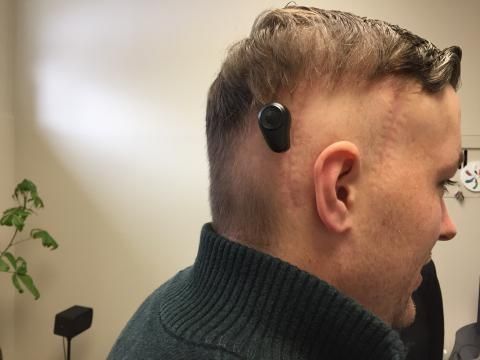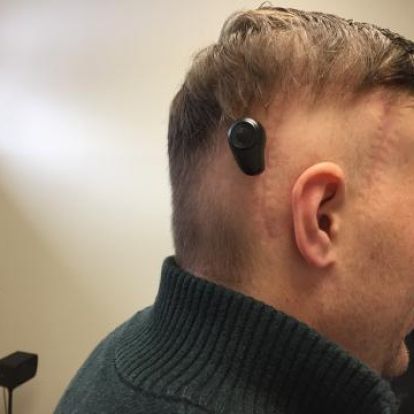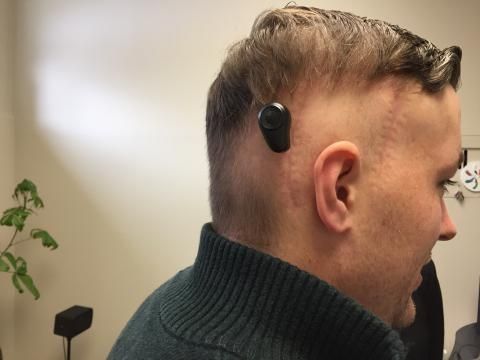Effective immediately masking is required for everyone when present on all inpatient units, in the Emergency Department (ED), the Urgent Care Centre (UCC), and the Children’s Outpatient Centre (COPC).

With several successful cases under its belt, an innovative new program is officially underway at Kingston Health Sciences Centre (KHSC) to restore hearing to many patients who can’t be treated with regular hearing aids.
The Bone Anchored Hearing Aid (BAHA) program in the Departments of Otolaryngology and Audiology/Speech Language Pathology at the Hotel Dieu Hospital (HDH) site has been approved to implant 10 BAHA devices each year. This is welcome news for the many patients who have been identified as candidates for this treatment. Patients from our region previously needed to travel outside of our LHIN for the procedure.
While most hearing aids are inserted into the ear canal and/or held behind the ear, a BAHA is connected to a titanium implant in the skull, where it conducts sound directly to the inner ear.
“Regular hearing aids transmit sound that travels through the eardrum and middle ear to our inner ear,” explains clinician-scientist and Otolaryngologist-Head and Neck Surgeon Dr. Jason Beyea. “But the BAHA bypasses that route and instead sends the sound directly to the patient’s inner ear, with excellent sound quality.”
In the BAHA procedure, a titanium implant is surgically placed into the bone behind the ear. The procedure takes less than 15 minutes and is typically done with local freezing. Once the implant has healed in place, a sound processor is attached and activated, providing transmission of sound and significant hearing improvement for the patient.
The system works in both adult and pediatric cases where the eardrum and bones of hearing are not working, explains Dr. Beyea. For example, children who are born without an ear canal are candidates for the procedure because a BAHA bypasses the ear canal.
While not all people with hearing loss can benefit from a BAHA, those who are candidates are thrilled with the results of the new technology. Just ask Adam Pennock, who opted for the implant after losing much of his hearing in one ear from cancer.
“My hearing was quite muffled until Dr. Beyea performed the procedure,” says Kingston’s first BAHA recipient. “Now my hearing is excellent. I can easily adjust the volume and microphone on the sound processor, and even make wireless connections. It’s very cool technology.”
“In the past few years BAHA technology has improved by leaps and bounds in terms of sound quality, power capabilities and feedback reduction,” says audiologist Bonnie Cooke. “It’s very satisfying to be able to offer this treatment close to home.”
Along with Dr. Beyea, Dr. Edmund Jones will also perform this BAHA procedure. The surgery portion is publicly funded by OHIP, with device funding coming through KHSC and the Departments of Otolaryngology and Audiology/Speech Language Pathology. The device is provided at no charge for children and is mostly subsidized for adult patients.
“We’re extremely excited about the approval of this program because it ensures long-term sustainability,” says Dr. Beyea. “We’re very thankful to KHSC for their tremendous support of this innovation.”
Gallery


In the BAHA procedure, a titanium implant is surgically placed into the bone behind the ear. Once the implant has healed in place, a sound processor is attached and activated, providing transmission of sound and significant hearing improvement for the pa



